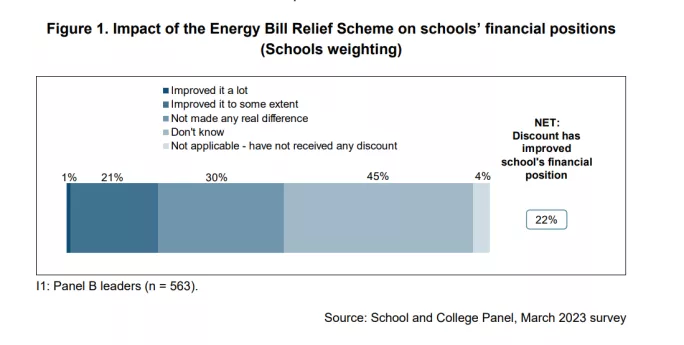Costs crisis: Just 20% of schools said energy relief scheme helped

Just one in five teachers and leaders said the government’s Energy Bill Relief Scheme (EBRS) helped their school cope with rising costs and only 1 per cent said it had made a big difference, a new Department for Education survey has revealed.
New School and College Panel reports published by the department at the end of term provide a stark picture of how the cost-of-living crisis has impacted schools this year.
The responses show that the majority of schools where respondents worked were turning the heating down or off and cutting back on the use of course materials to cope with rising inflation.
Almost half of the respondents also told the DfE that their school was reducing non-teaching staff numbers to cut costs while one in five said their schools were reducing teaching staff.
- Revealed: DfE sets out details of energy support for schools
- Support: Schools will be covered by six month bill relief
- Investigation: School warn of catastrophic winter as five fold fuel cost increases bite
The DfE has carried out surveys through its panels since 2021 to help it shape and inform its policies.
It has now published two reports from surveys carried out in January and March this year. Both are based on responses from more than 2,000 school teachers and more than 1,000 school leaders
Five-fold increase in bills
In 2022, the EBRS was launched with the aim of cutting the costs of gas and electricity prices over the winter. The scheme was intended to run for six months up until the end of March of this year. The government created the scheme for non-domestic customers after schools warned that they were facing a five-fold increase in fuel bills.
In the DfE survey responses in March about two out of every 10 schools (22 per cent) reported that the discount received via the EBRS had improved their financial position, with 30 per cent reporting that it had not made any real difference. Another 45 per cent said they didn’t know.
The breakdown shows that 21 per cent said the scheme had improved a school’s position to some extent and only one per cent said it had improved it a lot.

Turning the heating down and cutting resources
Two months earlier, the responses in January’s survey showed that three in 10 (30 per cent) reported the scheme as having an impact, the most common of which was not having to turn the heating off or down as much as they would otherwise have done (24 per cent).
However, just over a quarter of schools (27 per cent) felt that the discount received via the scheme was not sufficient to have had any impact.
The January survey also showed that the vast majority of schools were taking action or planned action as a result of recent inflation and the rise in the cost of living.
The most commonly reported actions were turning the heating down or off (60 per cent) and cutting back on the use of course materials (58 per cent)
The responses also showed that schools were also making a series of other cost-cutting measures.
About one in five said their school was reducing teaching staff. This was the case for 19 per cent of respondents including more than a quarter (26 per cent) of those working in secondary schools.
Four in ten teachers and leaders in secondary schools said their school was increasing class sizes. This was less prevalent in primary schools, where 13 per cent of respondents reported that this was happening.
The reports also highlight the impact of the cost-of-living pressures on school meals.
More than six in 10 respondents from schools (63 per cent) reported that the amount their school pays per meal had increased this academic year compared with the previous one, and just over half (53 per cent) had increased what they charge parents and pupils for meals.
Three in 10 schools (31 per cent) also reported a decrease in the quality of the food, and a quarter (25 per cent) reported a decrease in portion size compared with the previous academic year.
You need a Tes subscription to read this article
Subscribe now to read this article and get other subscriber-only content:
- Unlimited access to all Tes magazine content
- Exclusive subscriber-only stories
- Award-winning email newsletters
Already a subscriber? Log in
You need a subscription to read this article
Subscribe now to read this article and get other subscriber-only content, including:
- Unlimited access to all Tes magazine content
- Exclusive subscriber-only stories
- Award-winning email newsletters
topics in this article



